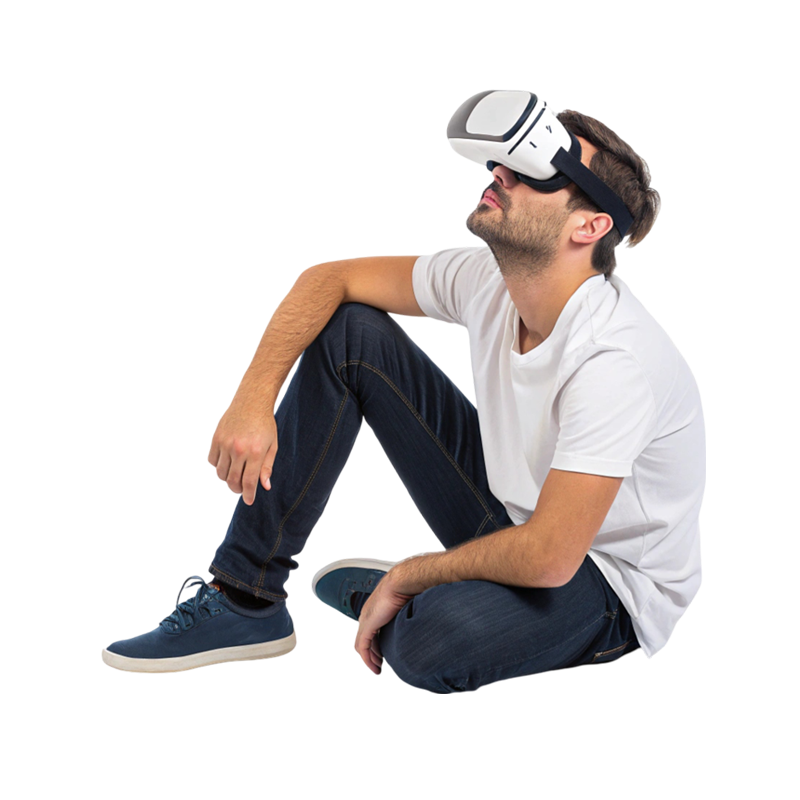

THE AUTHOR
George Philip
Sr. Vice President (Data Analytics and Emerging Technologies)
Table of Content
- An introduction to Augmented Reality
- What is Augmented Reality?
- How Does Augmented Reality Work?
- Interested in Taking a Peek into The Latest Trends in AR and the News AR is Making Across the World?
- A Deep Dive into the World of AR with Gartner insights on AR Trends
- Unique Applications and Benefits of AR and its Several Forms
- How Businesses Can Leverage AR for Growth
- FAQs for Augmented Reality
An introduction to Augmented Reality
What happens when digital technology seamlessly integrates with everyday objects around us? The answer to that would be a synchronization of digital technology and our world. This cyber-reality makes our world more interactive and redefines the flow of information from our world to our devices and vice versa. This transformative technology is popularly known to us as AR or Augmented Reality. It not only enhances our experiences with the world but blurs the lines between the digital and the physical in a revolutionary way.
What is Augmented Reality?
AR integrates digital technology with our real world while enhancing our experience of the world in a techno-realistic way. The term techno-realistic in our case is an acronym for technology infused reality and not the popular term technorealism which deals with the social and political implications of technology on our world. It would be better to call it cyber-realism since it infuses digital technology with our real world, making it more interactive and immersive.
How Does Augmented Reality Work?
Augmented reality works by overlaying digital content onto the real world. This enhances the user’s perception without changing the reality. Augmented reality works by leveraging the cameras, sensors, and display of smartphones, tablets, and other headsets which are AR enabled to create an immersive experience to the user.
Augmented reality technology works using accelerometers, gyroscopes, cameras, and GPS to study the environment before overlaying it with digital information that creates a depth perception to the user’s view by enhancing the real-world space.
AR - A Technology Paving way for the Integration of Digital and Physical realms.
Interested in Taking a Peek into The Latest Trends in AR and the News AR is Making Across the World?
Artificial Intelligence in AR
- AI in AR: AI is increasingly becoming integrated to AR in areas such as object recognition, language transcription, human detection. Some significant examples of AI in the field of AR are Apple’s face scanning and Google’s translate feature that recognizes text for translation.
- Generative AI: The future of AR can be said to involve AI on a large scale since AI models can generate 3D objects and animation using natural language and enhancing the capabilities of AI in the realm of AR-based content creation
AR in Mobile Devices
- Smartphones and AR: Key developments in AR’s journey with smartphones includes object recognition, text recognition, barcode recognition, ID recognition, or a combination of them all. Smartphones remain the largest segment in AR usage with a global user base projected to increase to 1.20 billion mobile AR users.
- ARCore and ARkit updates: Recent developments in ARCore and ARKit updates have boosted AR presence and uses on iOS and Android devices. This means improvements in object detection and improved motion capture technology.
Wearable AR Experiences
- Even as mixed reality devices such as Apple Vision Pro have seen limited sales, there lies a wide scope for wearable AR devices. The Apple vision pro takes advantage of software such as ARKit and SwiftUI.
- Meta Quest Series: Meta’s wearable devices such as the Quest Series offer a relatively affordable AR experience with actions such as hand-tracking and Augmented Reality games.
Industry Uses
- Automobile industry: AR in the field of automotives offers a wide range of experiences such as car sales, remote assistance, parking spot detection, and detection of a driver’s drowsiness. Its latest innovation includes 3D heads up display for cars.
- Business applications and Education: Retailers use AR to give prospective customers a hands-on experience while education industries use AR for learning simulations to help kids learn.
Future of AR
- Mainstream Extended Reality: The AI and AR duo are set to bring in a revolutionary extended reality to the mainstream. This means potential for AR to be used in out-of-home environments such as retail stores and events.
- Metaverse AR: Despite a lack of development in the field of social AR, there seems to be a growing demand for AR in basic applications irrespective of the capabilities of virtual world connectivity.
A Deep Dive into the World of AR with Gartner insights on AR Trends
AR Connected Workforce: Gartner emphasized an “Augmented Connected Workforce” which bridges skills gap among employees and boost worker capabilities. This move also signifies a trend in movement from automation in the workforce to augmentation.
Spatial Computation: By creating immersive environments, spatial computing aims to enhance the physical world by integrating digital technology with the real world to create digital content and immersive experiences. Anchored content with immersive experiences consumed on a weekly basis is expected to reach 20% of the people by 2028.
Business Transformation: AR is seen as a technology that is not only a tool for efficiency but as a catalyst for transformation where technology meets the real world and drives innovation beyond efficiency gains.
Market Share: The AR and VR market is projected to rise to 370 billion by 2034 even as the AR and VR head mounted displays market is not expected to cross the benchmark by 2030.
Sales transformation: The AR technology is expected to drive sales and enhance the customer experience by adding the factor of immersiveness. Thus, virtual sales will rise due to the transformational experience that AR brings in.
Unique Applications and Benefits of AR and its Several Forms
What are the types of AR and what are each of its unique applications and benefits. We will see this as follows.
Marker-based AR: This type of AR is based on visual cues such as QR codes or images which set off the device’s camera which then adds context to the images in the form of digital content. Examples are barcode scanners and image-recognition technologies which provide relevant information to the user upon the user’s device scanning an image via its camera.
Markerless AR: This type of AR is also known as location-based AR. It uses GPS, accelerometers, and digital compasses to determine the user’s location after which it renders relevant information over the screen for the user to make decisions. Examples are navigational systems and games that use real-world maps.
Projection-based AR: This type of AR projects images onto the real world to create interactive displays. For example, a furniture store would create digital images of their furniture which you can project onto a physical space like a house to get a sense of how it would fit in the space. That is the use case of a projection-based AR.
Superimposition-based AR: This type of AR superimposes digital content onto real-world images. For example, image filters and custom design filters which enhance the real-world image and convert it into a digital avatar so to speak fall under the category of superimposition-based AR.
Spatial AR: This is an advanced form of AR which allows for imposition of digital content onto the real-world objects without requiring a specific marker or a device. Engineering tasks and design tasks could leverage this to enhance real world objects using digital content.
Face and Body Tracking AR: This type of AR tracks facial and body movements and overlays digital content onto the data to create a digital avatar of sorts. This is used by social media websites that use filter effects to create digital content from images of real people.
AR is revolutionizing the way in which we consume information from our surroundings and integrate it with digital technology. AR bridges the gap between the digital and the real-world using AI and other technologies which are present in our smartphones and other devices. We foresee a rise in AR combined with the growth in AI technology which will make our lives simpler, and the experience more immersive and interactive in ways unimaginable.
How Businesses Can Leverage AR for Growth
Businesses can leverage AR for growth by improving customer experience, effectivizing operations, and increasing sales. The following points contain more information on how businesses use AR for Growth.
- Enhancing customer engagement and brand experiences.
- Improving efficiency in training and operations.
- Using AR for better data visualization and decision-making.

Focus on you
FAQs for Augmented Reality
How does AR differ from VR?
Augmented reality overlays digital content onto the real world while Virtual Reality completely immerses you in a virtual environment.
What devices can be used for AR experiences?
AR can be used with smartphones, tablets, smart glasses and headsets equipped with cameras, sensors and displays.
How does AR work?
AR works by taking in the real-world environment with the help of cameras and sensors and then it processes that image and overlays digital content onto the captured environment.
What are the main types of AR?
Marker-based AR: Uses physical markers to trigger digital overlays.
Markerless AR: Relies on GPS or location-based data.
Projection-based AR: Displays digital images on surfaces using projectors.
Superimposition-based AR: Replaces parts of the real world with digital augmentation.
Share this article
Facebook
LinkedIn
Twitter
Use AI to summarize this article




